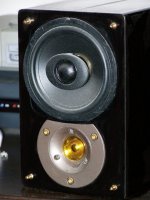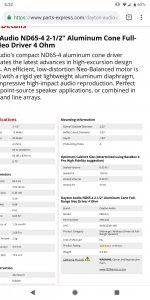Those would be perfect. I don't think there's enough data given to calculate the PR resonance, but they almost always need to have mass added.
Once assembled, I'd run a loud-ish sine sweep, and see where the main cones stop moving. That indicates your PR tuning. Then you can adjust the PR mass to get it where you want it to be. If it really needs to be lighter, sanding away some of the PR surface might be safe, depending on the material. Alternatively, a silicone-based glue could be applied to the surround of the PR to reduce compliance, also pushing the resonance up.
Chris
Thanks. I think I'll try it.
Now... I think these are often used in pocket-sized speakers with almost no airspace inside the enclosure, so it wouldn't surprise me if the resonant frequency of the PR was very low when placed in a box that is comparatively large (compared to something like a jambox for instance). If it does resonate at (for instance) 36Hz and my driver doesn't really put out any power at that frequency, will I still be able to tell where the resonant frequency is by doing the sine wave sweep?
I suppose I could just put the box in front of my big floor speakers that are very loud all the way down to 20Hz and use them as the power source and watch for the max excursion on the PR?
0.74 litre. Pretty close. To go that low in such a small box, it is not going to be very efficient.
And the required vent might be a significant factor in the size.
Frequency response ripple, caused by early reflections from the coupling chamber back thru the cone.
dave
In this case does it make sense to try to place some dampening material in the space between the two drivers?
It looks like there's a vent hole on the back of these drivers. Does this mean I should not mount them with the magnets actually in contact with each other? Does it matter? I dont't know how much heat will be an issue. I'm not planning to use these anywhere near their power rating.
Last edited:
Have a look at Fountek Fr58ex I have some in 1 litre boxes and with equalisation they can get to about 70hz
Smooth sound with probably more top end extension than the Daytons.
Simon
Looks like they'd be worth trying if I do this again. Just placed orders for all my parts yesterday, so I'll see how the daytons work.
What kind of enclosure did you use? Was it a powered speaker? I'm trying to decide if I want to include any kind of tone control or eq. I've seen a couple small prebuilt boards with passive tone controls. Don't think I want to add a preamp stage or active eq.
I used them in a pair of 1 litre bass reflex boxes powered by a tda7297 amp and equalised with iTunes on my computer.
I am pretty sure they would be a good choice for portable use but so are the Daytons you have.
If you are able to equalise using your phone or MP3 player, you will simplify things a lot it's not perfect but probably better than tone controls.
Oh and make sure you don't go with narrow ports or you will get chuffing as I found out for myself!
Simon
I am pretty sure they would be a good choice for portable use but so are the Daytons you have.
If you are able to equalise using your phone or MP3 player, you will simplify things a lot it's not perfect but probably better than tone controls.
Oh and make sure you don't go with narrow ports or you will get chuffing as I found out for myself!
Simon
Last edited:
I tried 18mm to start with which chuffed quiet a bit , then had to replace with 22mm which is mostly okay.
The only problem is that the larger pipe now extends out he back of the box.
If I started the project again I would probably oversize the boxes a little which can allow you to use a slightly shorter pipe to get the same tuning.
This problem particularly affect the small Daytons so you might research what others have built for these.
Simon
The only problem is that the larger pipe now extends out he back of the box.
If I started the project again I would probably oversize the boxes a little which can allow you to use a slightly shorter pipe to get the same tuning.
This problem particularly affect the small Daytons so you might research what others have built for these.
Simon
I have a separate thread in which I asked docudrama about vents for small boxes. In playing around with WinISD, I noticed that using 3x6mm vents as opposed to a single 12mm vent, the "vent Mach" number was reduced from an unacceptable number to a marginally acceptable number and since the cross sectional area is similar, the recommended length stays about the same.
I don't know if winisd is calculating accurately for this circumstance, but I was curious to try it.
I've decided to try a passive radiator instead this time.
I don't know if winisd is calculating accurately for this circumstance, but I was curious to try it.
I've decided to try a passive radiator instead this time.
Parts Express has some 3.5" PRs too. There is more info on it, may make it easier to model: Peerless 830878 3-1/2" Passive Radiator
great thread guys....
It seems to me that this is where the hobby can really get interesting, particularly for the iAge folks and users. I had done a retrofit to a pair of TEAC LS-H100 speakers from one of their "Reference 100" mini systems that worked out well.Maybe a little large for some to use as a travel system, but easily worth the effort. I disconnected the tweeters from the crossover, removed the factory woofers, and shoe horned a pair of (slightly) larger Vifa co-axials.
You can use whatever physically small amp/preamp you have, and use a typical mini-jack as an input, a USB analog input, or a little passive dock. But at 87dB you may need an amp with a little grunt. The port can be tuned a bit with some Dacron or straws. Listening without any "good" comparative speakers, it seems like they're pretty good, even in a home environment. Unfortunately they can be easily outclassed by good budget speakers, but for $30, how can you complain?
It seems to me that this is where the hobby can really get interesting, particularly for the iAge folks and users. I had done a retrofit to a pair of TEAC LS-H100 speakers from one of their "Reference 100" mini systems that worked out well.Maybe a little large for some to use as a travel system, but easily worth the effort. I disconnected the tweeters from the crossover, removed the factory woofers, and shoe horned a pair of (slightly) larger Vifa co-axials.
You can use whatever physically small amp/preamp you have, and use a typical mini-jack as an input, a USB analog input, or a little passive dock. But at 87dB you may need an amp with a little grunt. The port can be tuned a bit with some Dacron or straws. Listening without any "good" comparative speakers, it seems like they're pretty good, even in a home environment. Unfortunately they can be easily outclassed by good budget speakers, but for $30, how can you complain?
Attachments
Last edited:
Vent volume does add to box volume. You don't want to make it too small or it may chuff.
I did a miniOnken in the same volume as the SS 10F, i had to double the vent back an extra time to get enuff length while maintaining a reasonable cross-section.
dave
PS: the ND65 is an Aura OEM driver. As a generalization, the small Aura tend to go quite low for their size.
Hey Dave, that design for the ND65's what was it tuned to?
I only ever used the Aura in a sealed box (for the NS3), about 1-2 litres works well. Gregg-the-Geek did a BIG reflex for it, i was not stuffed about it, but it was OK. The ND65 is probaby a size down.
dave
I think I watched that video on YouTube last night, if it was the one with an L port. I was most interested in anything that could actually get an FS near 60hz, as I couldn't
I get the impression that there may be a bit of false advertising at play here, I know I fell victim to the bass box pro sizing and even replicated something similar in WiniSD (a bit higher around 60) but was shocked when it started to distort at half volume.even with a trial of a much longer port sticking well out the box. I can't recall what Greg did with the L port but I was impressed with the sound (even through YouTube)
Attachments
I get the impression that there may be a bit of false advertising at play here, I know I fell victim to the bass box pro sizing and even replicated something similar in WiniSD (a bit higher around 60) but was shocked when it started to distort at half volume.even with a trial of a much longer port sticking well out the box. I can't recall what Greg did with the L port but I was impressed with the sound (even through YouTube)
One thing Zaph recommended for the Aura NS3 (similar frame design) was to glue the driver in as well as screw it. If asked to bass, the frame can bobble against the baffle causing buzzing. Unless you're seeing large excursions.....
- Status
- This old topic is closed. If you want to reopen this topic, contact a moderator using the "Report Post" button.
- Home
- Loudspeakers
- Full Range
- Isobaric design for mini travel speaker?

